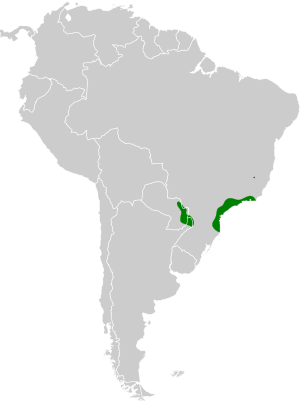Black-fronted piping guan facts for kids
The black-fronted piping guan (also known as jacutinga in Brazil) is a special type of bird. It belongs to the same family as chachalacas, guans, and curassows, called Cracidae. You can find this bird in Argentina, Brazil, and Paraguay.
Quick facts for kids Black-fronted piping guan |
|
|---|---|
 |
|
| At Iguazu, Argentina | |
| Conservation status | |
| Scientific classification | |
| Genus: |
Pipile
|
| Species: |
jacutinga
|
 |
|
| Synonyms | |
|
|
Contents
What is a Black-fronted Piping Guan?
The black-fronted piping guan is a unique bird from the family of chachalacas, guans, and curassows. It is known by its scientific name, Pipile jacutinga. This bird lives in parts of South America.
How Scientists Classify This Bird
Scientists group living things into different categories. The black-fronted piping guan is one of four species in the Pipile group. Some scientists have debated if there should be more or fewer species in this group. However, most agree that the black-fronted piping guan is its own distinct species.
What Does the Piping Guan Look Like?
The black-fronted piping guan is a medium-sized bird. It is about 63.5 to 74 centimeters (25 to 29 inches) long. It weighs between 1100 and 1400 grams (2.4 to 3.1 pounds). It looks a bit like a slim turkey with a thin neck and small head.
Its body is mostly black with a shiny blue tint. It has a bright white patch on its wings with black dots. The bird also has a large white crest on its head. A red wattle hangs from its throat, with a dark blue patch in front. Its dark eyes are surrounded by bare white skin. The face and forehead are covered in black feathers. Its legs and feet are red.
Where Does the Piping Guan Live?
This bird used to live in many places, but now it is found in smaller areas. You can find it near the coast of Brazil, from Paraná state north to Rio de Janeiro. It also lives in northeastern Misiones Province in Argentina and nearby eastern Paraguay.
The black-fronted piping guan lives in different types of Atlantic Forest. This includes evergreen forests, gallery forests (forests along rivers), and coastal forests. It prefers old, untouched forests. Sometimes, it can be found in older regrown forests or restinga areas. It used to live as high as 1,850 meters (6,070 feet) above sea level. Now, it is usually found below 1,000 meters (3,300 feet).
How Does the Piping Guan Behave?
Moving Around
The black-fronted piping guan sometimes moves to different elevations or changes its location with the seasons. Scientists are still studying why these movements happen.
What Does It Eat?
This bird looks for food alone, in pairs, or in small groups of up to 11 birds. They usually forage in trees but sometimes on the ground. Their main food is fruit. Studies in Brazil have shown they eat fruit from 41 different plant species. They also sometimes eat seeds, buds, insects, and small snails. They tend to stay in an area with fruit trees until all the fruit is gone.
How Does It Raise Its Young?
The breeding season for the black-fronted piping guan seems to be from August to December. This is based on when people have seen their displays, eggs, and young birds. Their nest is a platform made of twigs and stems. They build it in the fork of a tree. A female bird usually lays two to four eggs. The female does most of the incubating (keeping the eggs warm). Both parents feed the young birds.
Sounds and Calls
The main sound the black-fronted piping guan makes is a series of thin, rising whistles. These sounds are similar to other birds in its group. Its alarm call is also like other Pipile birds, but it has a more metallic sound. At dawn and dusk, they perform a wing-whirring display. This display includes two silent wingbeats, a long dry rattling sound, two more quick wingbeats, and then an even longer rattle.
Is the Piping Guan in Danger?
The IUCN (International Union for Conservation of Nature) has listed the black-fronted piping guan as Endangered since 2004. This means it is at a very high risk of becoming extinct. Its population and the areas where it lives have shrunk a lot. This is mainly because its habitat is being destroyed and because people hunt it.
Now, it is rare to see this bird outside of protected areas. Even in these protected places, illegal hunting for food and feathers is still a problem. Protecting its forest home and stopping poaching are very important to help this bird survive.
See also
 In Spanish: Yacutinga para niños
In Spanish: Yacutinga para niños


